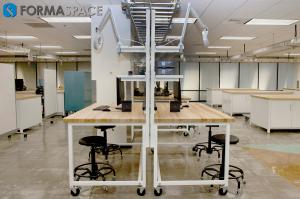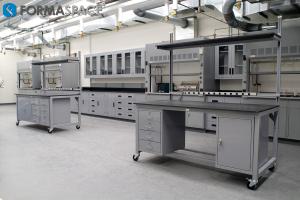What are the key aspects of sustainable lab design?
Do you want to implement sustainable lab practices in the facility you are designing? Read this article on how to make a lab more eco-friendly!
Traditional Laboratories Consume High Rates of Energy and Other Resources: Green Lab Design Can Help
Are you concerned about your laboratory’s high energy costs? Do you want to implement sustainable lab design practices in your facility?
You are not alone.
As many facility managers have discovered, laboratories can be stubbornly inefficient when it comes to conserving energy and natural resources.
On a daily basis, traditional laboratories use as much as 5 times more energy than a comparably-sized office, according to the National Renewable Energy Lab, (NREL) located in Golden, Colorado.
Why is this? There are multiple reasons:
Unlike offices, laboratories are often available for 24×7 access by researchers, and many experimental processes simply cannot be shut down during overnight hours.
Many types of lab equipment consume energy at far higher rates than equipment typically found in the office. Many experiments generate high levels of heat, which must be dissipated by the HVAC system.
Safety protocols dictate special considerations for air flow handling and waste removal to prevent exposure to dangerous materials; this often results in costly conditioned air being vented through high-power exhausts rather than recycled through the HVAC system — and water and other chemicals being channeled to isolated drain and treatment systems.
Research needs in the lab can also dictate special requirements that can increase energy use, such as the need to maintain precise control over air or water temperature, the need to maintain electrical power (necessitating the need to install uninterruptible power systems), as well as isolation systems designed to reduce vibration to a minimum for very sensitive experiments.
Tips for Lab Architects Wanting to Create Green Lab Designs
What should lab architects do to create a greener, more sustainable laboratory? Here are three practical suggestions.
1. Clever Design Solutions (Such as Modular Furniture) Can Help Future Proof Your Existing Laboratory
Not everyone has the luxury of moving into a brand new “green” laboratory facility.
One reason is that today’s facility budgets are often tight — especially at a time when limited availability is driving up the cost of leasing new laboratory in the major life science research clusters, such as Boston, New York / New Jersey, or San Diego.
If you feel you’ve outgrown your existing facility, we invite you to take another look.
Remember: the biggest cost saving of all is avoiding the need to move into a new facility.
There are many examples where Formaspace Design Consultants have been able to transform existing facilities into more modern, flexible, and space efficient facilities. For example, we were able to help Craig Venter’s teamwork more efficiently in their quest to be the first to sequence the human DNA by building 150 custom lab furniture carts that could safely move $140k sequencers (each weighing over 400 pounds) in and out of the laboratory without disrupting the ongoing research. In the video below, you can see images of the bench solutions we created for them
(In the manufacturing arena, Formaspace was able to help a major computer manufacturer avoid spending $184 million on a new facility by making their existing building more space efficient by building custom furniture that doubled the workspace.)
Modular furniture is often the key to creating a more sustainable, greener2 laboratory. As technology changes, new types of lab equipment are finding their way into research facilities, driving changes in the way experiments are conducted. In turn, many labs require new, efficient floor plan and equipment configurations to accommodate emerging new technologies and new ways of performing research experiments. Using modular lab furniture, which can be reconfigured as your needs change, can help “future proof” your facility investment.
Labs kitted out with traditional fixed casework are difficult to reconfigure without expensive, time-consuming renovation downtime. Modular furniture from Formaspace is different: you can easily reconfigure the stainless steel work surfaces, metal cabinets, shelves, and storage units using simple hand tools — it’s also easy to add new matching benches, shelves, cabinets, etc. as needed. This means you can make changes to your lab floor plans as your needs evolve — such as adding eco-friendly design elements, enlarging lab spaces or dividing existing ones into two — without having to go through a long disruptive renovation.
Modular lab furniture is a sustainable choice in other ways as well. If you ultimately decide to expand to a new location, modular furniture can be reassembled in the new facility without losing your investment (possibly earning you some LEED credits for recycling in the process), while fixed casework lab components may well end up in the solid waste landfill. It’s also important to note that the modular furniture materials themselves, e.g. the stainless steel shelves and work surfaces as well as heavy-duty steel support frames, are also recyclable and can easily be re-purposed for new uses.
2. Sustainable Design Practices Can Save Money by Reducing Waste and Reducing Energy Consumption from the Grid
Given that laboratories typically use five times more energy than comparable office spaces, lab architects and facility planners will want to explore all available options to reduce energy consumption and waste when designing a new laboratory facility (or making major renovations to an existing one).
When possible, green labs are typically oriented on-site to optimize solar gain during the winter while protecting interiors from the summer sun. (Smart sensors can also move sunscreens throughout the day to manage solar gain.) Other green building techniques to consider include incorporating green roofs (equipped with solar panels, white reflective surfaces, or earth-covered), protecting the building from cold northern exposures by building into a hill (or an artificial berm), or installing Subterranean Heating and Cooling Systems (SHCS) that use the latent heat from deep underground to reduce heating and cooling costs.
Super insulation technologies are also fast becoming more mainstream, which has enabled many residential and office facilities to reduce their energy consumption to near zero (Energy Net Zero Building Designs) or even allow them to return surplus energy back to the electricity grid (Energy Net Positive Building Designs).
Can these techniques help green labs achieve energy independence?
Read more ... https://formaspace.com/articles/laboratory-furniture/sustainable-lab-design-key-aspects/?utm_source=linkedin&utm_source=einpresswire&utm_medium=social&utm_medium=content&utm_campaign=article-011718
Brooke Turner
Formaspace
8002511505
email us here
1 https://formaspace.com/articles/tech-lab/how-we-saved-our-client-84/
2 https://formaspace.com/articles/laboratory-furniture/modular-laboratory-furniture-vs-fixed-casework/
3 https://formaspace.com/workbench-gallery/#!search-results?product=10430&keyword=modular


